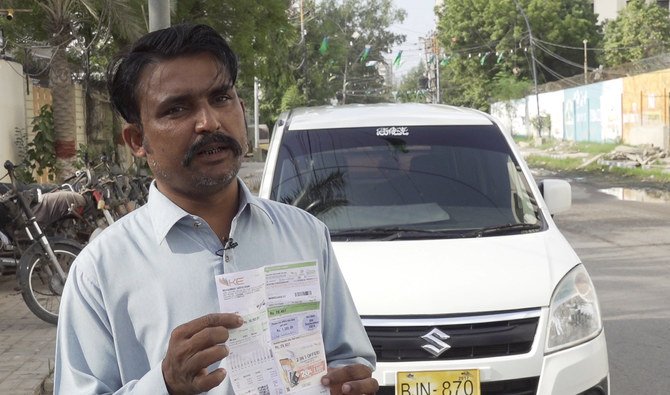Muhammad Amir Khan, working as a driver in a private company, has been gripped by despair for the past month.
His anguish began when he received an electricity bill totaling Rs28,457 ($95.99). With a meager monthly salary of Rs27,000 ($91.7), which constitutes his sole source of income to support a seven-member household, Khan found himself trapped with no viable option but to default on the payment.
His anticipation is now focused on the inevitable outcome: the power supply company disconnecting his electricity supply.
Khan‘s plight is far from unique.
Throughout the entire month of August, Pakistan witnessed nationwide protests and trader strikes fueled by the surging electricity prices and rapid inflation. In a demonstration of defiance and despondency, citizens and business owners resorted to burning their electricity bills. Although a $3 billion loan program, greenlit by the International Monetary Fund (IMF) in July, averted a sovereign debt default in Pakistan, the reforms tied to this bailout have contributed to an annual inflation rate of a staggering 27.4 percent.
READ: Residents of this village in Pakistan pay only Rs100 monthly electricity bills
Under the IMF agreement, Pakistan raised its power tariffs in July, as part of efforts to curb the unsustainable public debt plaguing the power and gas sectors. Consequently, tens of thousands of Pakistanis received exorbitant electricity bills in August for power consumed in July. To compound matters, Pakistan recently announced a record-breaking increase in petrol and diesel prices, marking the second substantial hike in just two weeks.
Khan voiced his predicament, saying, “My electricity bill [last month] was so exorbitant that I couldn’t afford to pay it. I was torn between paying the bill, buying food, or providing for my children. If my electricity gets disconnected due to non-payment, I’ll be forced to live in darkness because I lack any other resources.”
“How can I continue to sustain myself with an income that falls short of the electricity bill I’ve been burdened with?”
Inflationary pressures are inflicting severe hardships on the general populace. August data from Pakistan’s statistics bureau showed a slight easing from July’s 28.3 percent inflation rate, but food inflation remained alarmingly high at 38.5 percent.
Financial expert Ali Nawaz highlighted that low-income groups across the nation were struggling to make ends meet, as soaring food prices and record-breaking power bills significantly raised their cost of living.
“Higher electricity bills have substantially reduced their disposable income, impacting their livelihoods. They’re unable to cover daily expenses, healthcare costs, or food-related expenditures,” Ali explained.
He advocated for an urgent focus on lowering electricity prices by prioritizing alternative energy sources to provide relief to the general populace.
But what factors are contributing to the escalating electricity prices in Pakistan?
One key factor is the cost of non-renewable fuel resources such as gas, furnace oil, diesel, and coal, coupled with the weakening value of the Pakistani rupee against the US dollar. Energy purchases represent a significant portion of Pakistan’s import expenditures, and as the rupee depreciates against the dollar, the cost of imported fuel escalates.
The mandated increase in electricity prices under the IMF agreement has only exacerbated the issue. The IMF had identified acute liquidity challenges in the power sector, characterized by mounting arrears and frequent power outages. Arrears, which accumulate due to subsidies and unpaid bills, were a major sticking point in the eight months of negotiations between the IMF and Islamabad that led to the agreement in June.
Official figures indicate that debts owed to power generation companies have reached nearly 2.6 trillion rupees ($9.04 billion), with an additional government debt of around 1.6 trillion rupees ($5.56 billion) owed to the gas sector. The power sector also grapples with theft, a challenge that must be addressed.
With recent tariff hikes, the per unit price of electricity has surged to Rs35.57 for off-peak hours and Rs41.89 for on-peak hours. Previously, rates were Rs19.66 for off-peak hours and Rs25.98 for on-peak hours. Including various taxes, the per unit rates now range from Rs53 to Rs63 for different consumer categories.
Another contributor to the high cost of electricity is the “capacity payments” made to Independent Power Producers (IPPs), private entities that operate power facilities for end-user sales. Pakistan heavily relies on IPPs, with thermal power accounting for 58.8 percent of the energy mix. However, IPP contracts are widely criticized for favoring the companies.
Among the major criticisms of IPP contracts is the requirement for the government to make capacity payments even when power generation is not fully utilized. Experts contend that this arrangement drives up electricity costs, leading to higher production expenses for factories and industrial units. IPPs have also faced allegations of excessive profits and dividends on capital invested under existing contracts, as well as accusations of over-invoicing and misreporting. Politicians and experts have called for a heat rate audit.
Officials from the Power Division informed the Senate last month that capacity payments to IPPs for the current fiscal year had reached an astounding Rs1.3 trillion.
In a recent briefing to journalists, caretaker Prime Minister Anwaar-ul-Haq Kakar acknowledged issues with IPP agreements and stated that his government was thoroughly reviewing its contractual obligations with the producers. He expressed the need to find a resolution, as many perceive the contracts to be uneven. He pledged to provide further details in due course.
*This story is actually appeared in Arab News Pakistan


